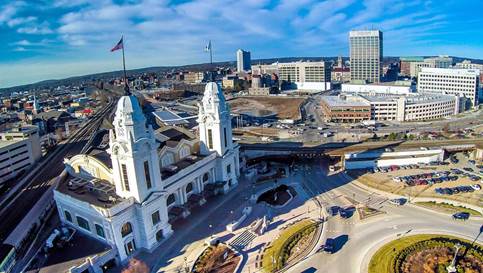
Boston – MassINC—a nonpartisan think-tank that has vigorously advocated for state investment in Gateway Cities over the years—has launched a new initiative aimed at better understanding and acting upon opportunities to make mobility a catalyst for economic development outside of Greater Boston.
The researchers will look closely at opportunities to cluster residential, office, and other forms of development around places with good transportation infrastructure to create vibrant urban hubs. This practice is now commonplace in and around Boston, where rail, bus, and a growing network of shared bike stations have led to revitalization both in the city and in neighboring communities like Somerville and Medford. In cities beyond the Boston urban core, it is much less common.
In this new study, MassINC will look to better understand how Gateway Cites—a term for regional urban centers outside of Greater Boston—get the most out of their existing transportation assets, like rail, and make smart investments in better bus, pedestrian, and bicycle infrastructure to become stronger drivers of more geographically-balanced economic growth.
“Massachusetts has been struggling with lopsided growth for too long and we’re making little headway addressing this problem,” said Ben Forman, MassINC’s research director. “It’s notable that we have underutilized transit connections to our regional cities already in place. We need to look at these rail assets carefully and figure out what can be done to squeeze more economic activity out of them.”
Massachusetts is uniquely positioned with a network of dense urban centers connected by passenger rail, service provided by the MBTA and/or Amtrak. While there has been some downtown building of late around these stations, these developments haven’t necessarily led to broader mobility improvements through greater use of transit. High fares, infrequent and unreliable service, and lengthy trips even over relatively short distances may be to blame. But experience in large cities like Boston suggest, it’s not just about the transit line; it’s also critical to plan for development to get the right mix of activity and appropriate scale in the station areas. When it all clicks, planners call it transit-oriented development (TOD).
With funding from the Barr Foundation, MassINC has assembled a team of experts in real estate development and transportation to look for the right recipe for Gateways Cities. This group will crunch the numbers working with local transportation and economic development officials in four case study cities—Fitchburg, Lynn, Springfield, and Worcester. Situated in different parts of the state, these communities will serve as models that the researchers can use to test different policy options to help Gateway Cities improve mobility and spur TOD.
“Perhaps it’s a matter of boosting ridership through adjusted fares or improving local mobility connections to train stations” said Dan Hodge of Hodge Economic Consulting, the lead researcher on the study. “Or maybe we need to look at enhanced tools to ensure that the market responds with increased levels of residential and commercial development in our station areas.”
Fitchburg Mayor Stephen DiNatale says “Fitchburg is fortunate to already enjoy the key components needed for successful TOD, such as our downtown multi-modal transportation center, Fitchburg State University as a source of academic and cultural activity, and our new Complete Streets efforts aimed at expanding walkability and cycling.” Building off these strengths, he believes “TOD will be truly transformative in our pursuit of development that expands the city’s economy while enhancing quality of life.”
Senator Eric Lesser, who co-chairs the Gateway Cities Legislative Caucus, also sees opportunity in smarter mobility and development decisions, and the value this analysis can provide policymakers. “For the Pioneer Valley economy to thrive, we need a transportation network that fits our 21st century economy. Policymakers need information like this to make informed decisions about how to best provide the services that will truly lead to economic growth across our Commonwealth,” Senator Lesser said.
###
